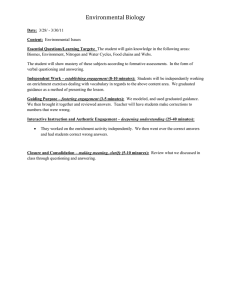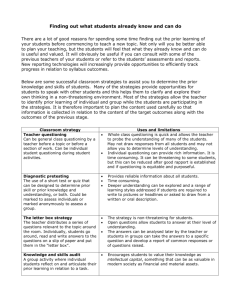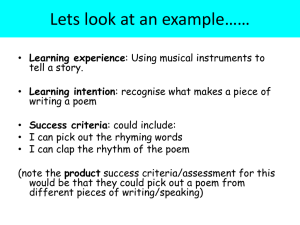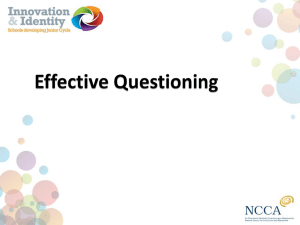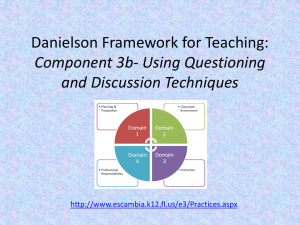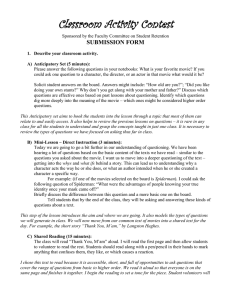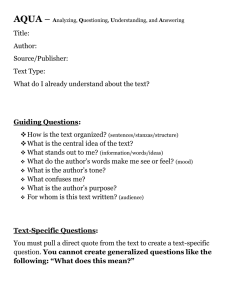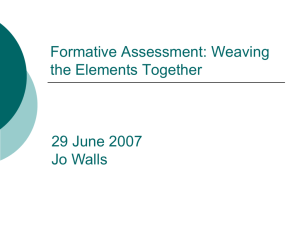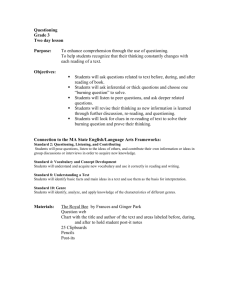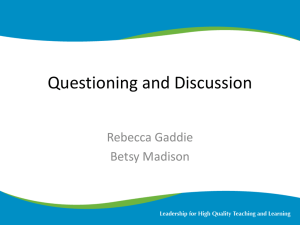Questioning PPT - Kelly Philbeck
advertisement
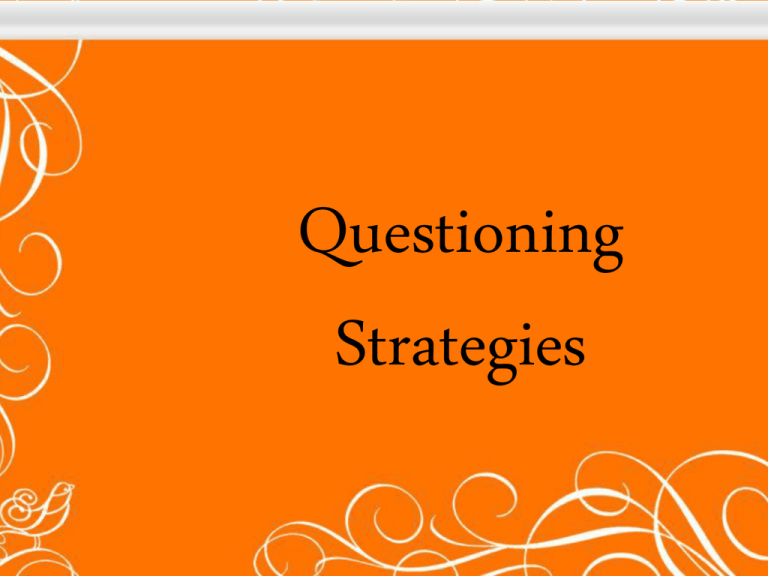
Questioning Strategies Warm-up: The Best Question Ever •Take a good look at the each photo •If you could ask this person/people only one question, what would it be? •The goal is to learn as much as you possibly can about who this person really is. Your question should not be too broad, nor too limiting. •Write your question. 1. 2. 3. 4. 5. 6. Habits Are Hard to Break A teacher with 20 years of experience will have asked something like a half a million questions in her career. And when you’ve done something the same way, half a million times, it’s quite difficult to start doing it another way. Questions (2003) Wiliam Questioning • On Average, a teacher asks 400 questions a day (one third of their time) • Most of the questions are answered in less than one second (Hastings, 2003) • 60% recall facts and 20% are procedural (Hattie, 2012) • Most answers are right or wrong Why do we ask questions? • To guide students toward understanding when we introduce material • To push students to do a greater share of the thinking in the classroom • To remediate an error • To stretch students • To check for understanding “Quality questions create a quality life. Successful people ask better questions, and as a result, they get better answers.” Anthony Robbins Closed Questions • Imply that teacher has a predetermined correct response in mind • Recall of facts • Simple comprehension where answer has been previously provided Open Questions • Allow for range of responses • Encourage students to think beyond literal answers • Help teacher to assess student’s understanding of content Strategies for Redeeming Closed Questions • • • • • A Range of Answers A Statement Right and Wrong Starting From the Answer/End Opposing Standpoint General Rules of Thumb For Effective Questioning One at a Time • Have you ever done this? – “Sarah, how is the rat’s house different from Mrs. Frisby’s and which one do you think she would rather live in?” • Do you want Sarah to compare and contrast specific details OR infer a character’s point of view on an event? • We are more tempted to do this when we are excited or in a hurry. • Consequences: – Students aren’t sure which question to answer. – Students skip the hard question. – Teacher can’t plan follow-up questions. Simple to Complex • Simple questions engage student thinking, and activate memory and opinions. • Simple questions build a fact base students can build on to argue more complex questions. • Correctly answering simple questions builds student confidence and increases the likelihood they will attempt harder questions. No Opt Out • A sequence that begins with a student unable to answer a question and should end with the student answering that question – 1. Teacher provides the answer; the student repeats the answer. – 2. Another student provides the answer; the initial student repeats the answer. – 3. You provide a cue; the student uses it to find the answer. – 4. Another student provides the cue; the initial student uses it to find the answer. (Video Clip 1) Wait Time— Think Time--Write Time--Talk Time • When 3 or more seconds of Wait Time is given… – …the length and correctness of student responses increases. – …the number of “I don’t know” and no answer responses decreases. – …the number of volunteered, correct answers increases. • When 3 or more seconds of Wait Time is given…. – …teacher questions are more varied and flexible – …the quantity of questions decreases and the quality increases – …teachers ask add on questions requiring higher-level thinking and processing (Video Clip 11) Think Time • 3 second minimum • Instruct students to take a “thinking moment” before you either open the floor for answers or, better yet, you choose a student to respond. • Write the question on the board, while students are thinking, for visual learners • Provides the students with a time of reflection and rehearsal Write Time • “I don’t know what I think until I write it down.” (Norman Mailer) • Especially helpful for tactile/kinesthetic learners • It’s not specifically the writing that helps the learning – Writing is an active, rather than passive, task – Writing involves more of the whole body in the process of thinking – Writing clarifies perspectives Talk Time • “If you have to talk, you have to think.” • The importance of dialogic talk – “ By the age of 4, the child of professional parents in the US will have had nearly twice as many words addressed to it as the working-class child, and over four times as many as a child on welfare. For the middle-class child, encouragement from parents vastly outweighs discouragement; but for the child on welfare the climate of adult reaction is an overwhelmingly discouraging one. While talk is essential for intellectual and social development, for some children, the talk which they engage in at school is nothing less than a lifeline.” – (Robin Alexander, 2004) Right is Right • What’s the difference between pretty good and 100% correct? • How do you respond to “almost right” answers? Right is Right • Many teachers respond to almost-correct answers by “rounding up.” They affirm and repeat the answer, adding the details to make it fully correct. • Most students stop processing when they hear the word “right.” • What does this communicate about the standard of correctness in your classroom? • Who’s doing the cognitive work? (Video Clip 3) How do you handle incorrect answers? • Say No to No • Why does Ms. Bannon focus on improving her questioning rather than simply telling students that an answer is not correct? • How does her approach build confidence? • My Favorite No • How does this strategy allow for immediate re-teach or intervention? • How does this approach of discussing what is correct and incorrect address both students' academic and psychosocial needs? Students asking Questions • Teachers take up to two-thirds of the classroom talk time. Students are “talk-deprived” (Alvermann et al., 1996) • Student discussion increases retention as much as 50%. (Sousa, 2001) Stretch It • A sequence of questioning that doesn’t end with the right answer. • Right answers are rewarded with follow-up questions that extend the knowledge and test for reliability. – – – – – – Ask how or why Ask for another way to answer Ask for a better word Ask for evidence Ask students to integrate a related skill Ask students to apply the same skill in a new setting Format Matters • “The complete sentence is the battering ram that knocks down the door to college” • Two Components –Correct grammar –Complete sentence format Format Matters • Identify the error – We was walking down the street – We were… • Provide the words to start the sentence – How many dogs are there? Six “There are…” Format Matters • Provide a reminder of the question – Who can tell me in a complete sentence how many dogs are left? • Provide a simple, direct prompt after the question – How many dogs are left? Six “Complete sentence please.” “Students in classrooms around the world are answering questions they never asked.” Visible Classroom Training Engaging Students in Effective Questions Teachers cannot teach (and students cannot learn) everything there is to know. (Brookhart, 2009) Authentic Questions Resources • Teach Like a Champion by Doug Lemov (Jossey-Bass Teacher) • Active Learning Through formative Assessment by Shirley Clarke (Hodder Education) • Advancing Formative Assessment in Every Classroom by Moss and Brookhart • Betsy Madison betsy.madison@grrec.ky.gov
